A Comprehensive Overview in Control Algorithms for High Switching-Frequency LLC Resonant Converter
Abstract
:1. Introduction
2. Control Algorithms for High Efficiency
2.1. Efficiency Improvement at Light Load
2.2. Resonant Frequency Tracking
2.3. Secondary Side Synchronous Rectification
3. Control Algorithms for Voltage Regulation and Dynamic Performance
3.1. Output Voltage Regulation
3.2. Fast Dynamic Performance
4. Control Algorithm for EMI Reduction
5. Conclusion
Author Contributions
Funding
Conflicts of Interest
References
- Hou, J.; Chen, Q.; Ren, X.; Ruan, X.; Wong, S.; Tse, C.K. Precise characteristics analysis of series/series-parallel compensated contactless resonant converter. IEEE J. Emerg. Sel. Top. Power Electron. 2015, 3, 101–110. [Google Scholar]
- Bonache-Samaniego, R.; Olalla, C.; Martínez-Salamero, L. Dynamic modeling and control of self-oscillating parallel resonant converters based on a variable structure systems approach. IEEE Trans. Power Electron. 2017, 32, 1469–1480. [Google Scholar] [CrossRef]
- Mao, M.; Tchobanov, D.; Li, D.; Maerz, M. Design optimisation of a 1 MHz half-bridge CLL resonant converter. IET Power Electron. 2008, 1, 100–108. [Google Scholar] [CrossRef]
- Borage, M.; Tiwari, S.; Kotaiah, S. LCL-T resonant converter with clamp diodes: A novel constant-current power supply with inherent constant-voltage limit. IEEE Trans. Ind. Electron. 2007, 54, 741–746. [Google Scholar] [CrossRef]
- Liu, Y.; Du, G.; Wang, X.; Lei, Y. Analysis and Design of high-efficiency bidirectional gan-based CLLC resonant converter. Energies 2019, 12, 3859. [Google Scholar] [CrossRef] [Green Version]
- Lin, B.-R. Implementation of a parallel-series resonant converter with wide input voltage range. Energies 2019, 12, 4095. [Google Scholar] [CrossRef] [Green Version]
- Lin, B.-R. Resonant converter with soft switching and wide voltage operation. Energies 2019, 12, 3479. [Google Scholar] [CrossRef] [Green Version]
- Li, F.; Hao, R.; Lei, H.; Zhang, X.; You, X. The influence of parasitic components on LLC resonant converter. Energies 2019, 12, 4305. [Google Scholar] [CrossRef] [Green Version]
- Lin, Y.-C.; Chen, D.-T.; Chen, C.-J. Flux-balance control for LLC Resonant converters with center-tapped transformers. Energies 2019, 12, 3211. [Google Scholar] [CrossRef] [Green Version]
- Yoon, D.; Lee, S.; Cho, Y. Design considerations of series-connected devices based LLC converter. Energies 2020, 13, 264. [Google Scholar] [CrossRef] [Green Version]
- Kim, E.-S.; Oh, J.-S. High-efficiency bidirectional llc resonant converter with primary auxiliary windings. Energies 2019, 12, 4692. [Google Scholar] [CrossRef] [Green Version]
- Cha, H.-R.; Kim, R.-Y. Voltage balance switching scheme for series-connected SiC MOSFET LLC resonant converter. Energies 2019, 12, 4003. [Google Scholar] [CrossRef] [Green Version]
- Watanabe, H.; Itoh, J.-I.; Koike, N.; Nagai, S. PV micro-inverter topology using LLC resonant converter. Energies 2019, 12, 3106. [Google Scholar] [CrossRef] [Green Version]
- Abdel-Rahim, O.; Alamir, N.; Abdelrahem, M.; Orabi, M.; Kennel, R.; Ismeil, M.A. A phase-shift-modulated LLC-Resonant micro-inverter based on fixed frequency predictive-MPPT. Energies 2020, 13, 1460. [Google Scholar] [CrossRef] [Green Version]
- Yang, J.-W.; Han, S.-K. A Si-FET-based high switching frequency three-level LLC resonant converter. Energies 2019, 12, 3082. [Google Scholar] [CrossRef] [Green Version]
- Gamand, F.; Li, M.D.; Gaquiere, C. A 10-MHz GaN HEMT DC/DC boost converter for power amplifier applications. IEEE Trans. Circuits Syst. II Express Briefs 2012, 59, 776–779. [Google Scholar] [CrossRef]
- Akuzawa, Y.; Ito, Y.; Ezoe, T.; Sakai, K. A 99%-efficiency GaN converter for 6.78 MHz magnetic resonant wireless power transfer system. J. Eng. 2014, 2014, 598–600. [Google Scholar] [CrossRef]
- Hariya, A.; Koga, T.; Matsuura, K.; Yanagi, H.; Tomioka, S.; Ishizuka, Y.; Ninomiya, T. Circuit design techniques for reducing the effects of magnetic flux on GaN-HEMTs in 5-MHz 100-W high power-density LLC resonant DC–DC converters. IEEE Trans. Power Electron. 2017, 32, 5953–5963. [Google Scholar] [CrossRef]
- Zhang, Y.; Rodríguez, M.; Maksimović, D. Very high frequency PWM buck converters using monolithic GaN half-bridge power stages with integrated gate drivers. IEEE Trans. Power Electron. 2016, 31, 7926–7942. [Google Scholar] [CrossRef]
- Chakraborty, S.; Vu, H.-N.; Hasan, M.M.; Tran, D.-D.; Baghdadi, M.E.; Hegazy, O. DC-DC converter topologies for electric vehicles, plug-in hybrid electric vehicles and fast charging stations: State of the art and future trends. Energies 2019, 12, 1569. [Google Scholar] [CrossRef] [Green Version]
- Feng, W.; Lee, F.C.; Mattavelli, P. Optimal trajectory control of burst mode for LLC resonant converter. IEEE Trans. Power Electron. 2013, 28, 457–466. [Google Scholar] [CrossRef]
- Feng, W.; Lee, F.C.; Mattavelli, P. Optimal trajectory control of LLC resonant converters for LED PWM dimming. IEEE Trans. Power Electron. 2014, 29, 979–987. [Google Scholar] [CrossRef]
- Fei, C.; Li, Q.; Lee, F.C. Digital implementation of light-load efficiency improvement for high-frequency LLC converters with simplified optimal trajectory control. IEEE J. Emerg. Sel. Top. Power Electron. 2018, 6, 1850–1859. [Google Scholar] [CrossRef]
- Lee, J.; Kim, J.; Kim, J.; Baek, J.; Moon, G. A high-efficiency PFM Half-bridge converter utilizing a half-bridge LLC converter under light load conditions. IEEE Trans. Power Electron. 2015, 30, 4931–4942. [Google Scholar] [CrossRef]
- Pan, H.; He, C.; Ajmal, F.; Chen, H.; Chen, G. Pulse-width modulation control strategy for high efficiency LLC resonant converter with light load applications. IET Power Electron. 2014, 7, 2887–2894. [Google Scholar] [CrossRef]
- Kim, J.; Kim, C.; Kim, J.; Lee, J.; Moon, G. Analysis on load-adaptive phase-shift control for high efficiency full-bridge LLC Resonant converter under light-load conditions. IEEE Trans. Power Electron. 2016, 31, 4942–4955. [Google Scholar]
- Fang, Z.; Huang, Z.; Jing, H.; Liu, F. Hybrid mode-hopping modulation for LLC resonant converter achieving high efficiency and linear behavior. IET Power Electron. 2020, 13, 1153–1162. [Google Scholar] [CrossRef]
- Kim, K.; Youn, H.; Baek, J.; Jeong, Y.; Moon, G. Analysis on synchronous rectifier control to improve regulation capability of high-frequency LLC resonant converter. IEEE Trans. Power Electron. 2018, 33, 7252–7259. [Google Scholar] [CrossRef]
- Nguyen, H.; Zane, R.; Maksimović, D. ON/OFF control of a modular DC–DC Converter based on active-clamp LLC modules. IEEE Trans. Power Electron. 2015, 30, 3748–3760. [Google Scholar] [CrossRef]
- Fei, C.; Ahmed, M.H.; Lee, F.C.; Li, Q. Two-stage 48 V-12 V/6 V-1.8 V voltage regulator module with dynamic bus voltage control for light-load efficiency improvement. IEEE Trans. Power Electron. 2017, 32, 5628–5636. [Google Scholar] [CrossRef]
- Feng, W.; Mattavelli, P.; Lee, F.C. Pulsewidth locked loop (PWLL) for Automatic resonant frequency tracking in LLC DC–DC transformer (LLC-DCX). IEEE Trans. Power Electron. 2013, 28, 1862–1869. [Google Scholar] [CrossRef]
- Li, H.; Jiang, Z. On automatic resonant frequency tracking in LLC Series resonant converter based on zero-current duration time of secondary diode. IEEE Trans. Power Electron. 2016, 31, 4956–4962. [Google Scholar] [CrossRef]
- Kundu, U.; Chakraborty, S.; Sensarma, P. Automatic resonant frequency tracking in parallel LLC boost DC–DC converter. IEEE Trans. Power Electron. 2015, 30, 3925–3933. [Google Scholar] [CrossRef]
- Kundu, U.; Sensarma, P. Gain-relationship-based automatic resonant frequency tracking in parallel LLC converter. IEEE Trans. Ind. Electron. 2016, 63, 874–883. [Google Scholar] [CrossRef]
- Kundu, U.; Sensarma, P. A unified approach for automatic resonant frequency tracking in LLC DC–DC converter. IEEE Trans. Ind. Electron. 2017, 64, 9311–9321. [Google Scholar] [CrossRef]
- Kundu, U.; Sensarma, P. A generalized low-cost solution for resonant frequency tracking in LLC converters. In Proceedings of the 2018 IEEE International Conference on Power Electronics, Drives and Energy Systems (PEDES), Chennai, India, 18–21 December 2018. [Google Scholar]
- Wu, X.; Chen, H.; Qian, Z. 1-MHz LLC resonant DC transformer (DCX) with regulating capability. IEEE Trans. Ind. Electron. 2016, 63, 2904–2912. [Google Scholar] [CrossRef]
- Feng, W.; Lee, F.C.; Mattavelli, P.; Huang, D. A universal adaptive driving scheme for synchronous rectification in LLC resonant converters. IEEE Trans. Power Electron. 2012, 27, 3775–3781. [Google Scholar] [CrossRef]
- Fei, C.; Li, Q.; Lee, F.C. Digital implementation of adaptive synchronous rectifier (SR) driving scheme for high-frequency LLC converters with microcontroller. IEEE Trans. Power Electron. 2018, 33, 5351–5361. [Google Scholar] [CrossRef]
- Wang, D.; Liu, Y. A zero-crossing noise filter for driving synchronous rectifiers of LLC resonant converter. IEEE Trans. Power Electron. 2014, 29, 1953–1965. [Google Scholar] [CrossRef]
- Hsu, J.; Ordonez, M.; Eberle, W.; Craciun, M.; Botting, C. LLC Synchronous rectification using resonant capacitor voltage. IEEE Trans. Power Electron. 2019, 34, 10970–19087. [Google Scholar] [CrossRef]
- Mohammadi, M.; Ordonez, M. Synchronous rectification of LLC resonant converters using homopolarity cycle modulation. IEEE Trans. Ind. Electron. 2019, 66, 1781–1790. [Google Scholar] [CrossRef]
- Park, H.; Jung, J. PWM and PFM hybrid control method for LLC Resonant converters in high switching frequency operation. IEEE Trans. Ind. Electron. 2017, 64, 253–263. [Google Scholar] [CrossRef]
- Zheng, R.; Liu, B.; Duan, S. Analysis and parameter optimization of start-up process for LLC resonant converter. IEEE Trans. Power Electron. 2015, 30, 7113–7122. [Google Scholar] [CrossRef]
- Mohammadi, M.; Ordonez, M. Inrush current limit or extreme startup response for LLC Converters using average geometric control. IEEE Trans. Power Electron. 2018, 33, 777–792. [Google Scholar] [CrossRef]
- Buccella, C.; Cecati, C.; Latafat, H.; Pepe, P.; Razi, K. Observer-based control of LLC DC/DC resonant converter using extended describing functions. IEEE Trans. Power Electron. 2015, 30, 5881–5891. [Google Scholar] [CrossRef]
- Park, H.; Jeong, S.; Kim, M.; Kim, J.; Jung, J. Spread spectrum technique for decreasing EM Noise in high-frequency APWM HB resonant converter with reduced EMI filter size. IEEE Trans. Power Electron. 2019, 34, 10845–10855. [Google Scholar] [CrossRef]
- Zahid, Z.U.; Lai, J.J.; Huang, X.K.; Madiwale, S.; Hou, J. Damping impact on dynamic analysis of LLC resonant converter. In Proceedings of the 2014 IEEE Applied Power Electronics Conference and Exposition—APEC, Fort Worth, TX, USA, 16–20 March 2014; pp. 2834–2841. [Google Scholar]
- Kang, S.; Kim, H.; Cho, B. Adaptive voltage-controlled oscillator for improved dynamic performance in LLC resonant converter. IEEE Trans. Ind. Electron. 2016, 52, 1652–1659. [Google Scholar] [CrossRef]
- Hu, Z.; Liu, Y.; Sen, P.C. Bang-bang charge control for LLC resonant converters. IEEE Trans. Power Electron. 2015, 30, 1093–1108. [Google Scholar]
- Park, H.; Kim, M.; Jung, J. Spread spectrum technique to reduce EMI emission for an LLC resonant converter using a hybrid modulation method. IEEE Trans. Power Electron. 2018, 33, 3717–3721. [Google Scholar] [CrossRef]
- Park, H.; Kim, M.; Jung, J. Spread-spectrum technique employing phase-shift modulation to reduce EM noise for parallel-series LLC resonant converter. IEEE Trans. Power Electron. 2019, 34, 1026–1031. [Google Scholar] [CrossRef]
- Park, H.; Jung, J. Modeling and feedback control of LLC resonant converters at high switching frequency. J. Power Electron. 2016, 16, 849–860. [Google Scholar] [CrossRef]

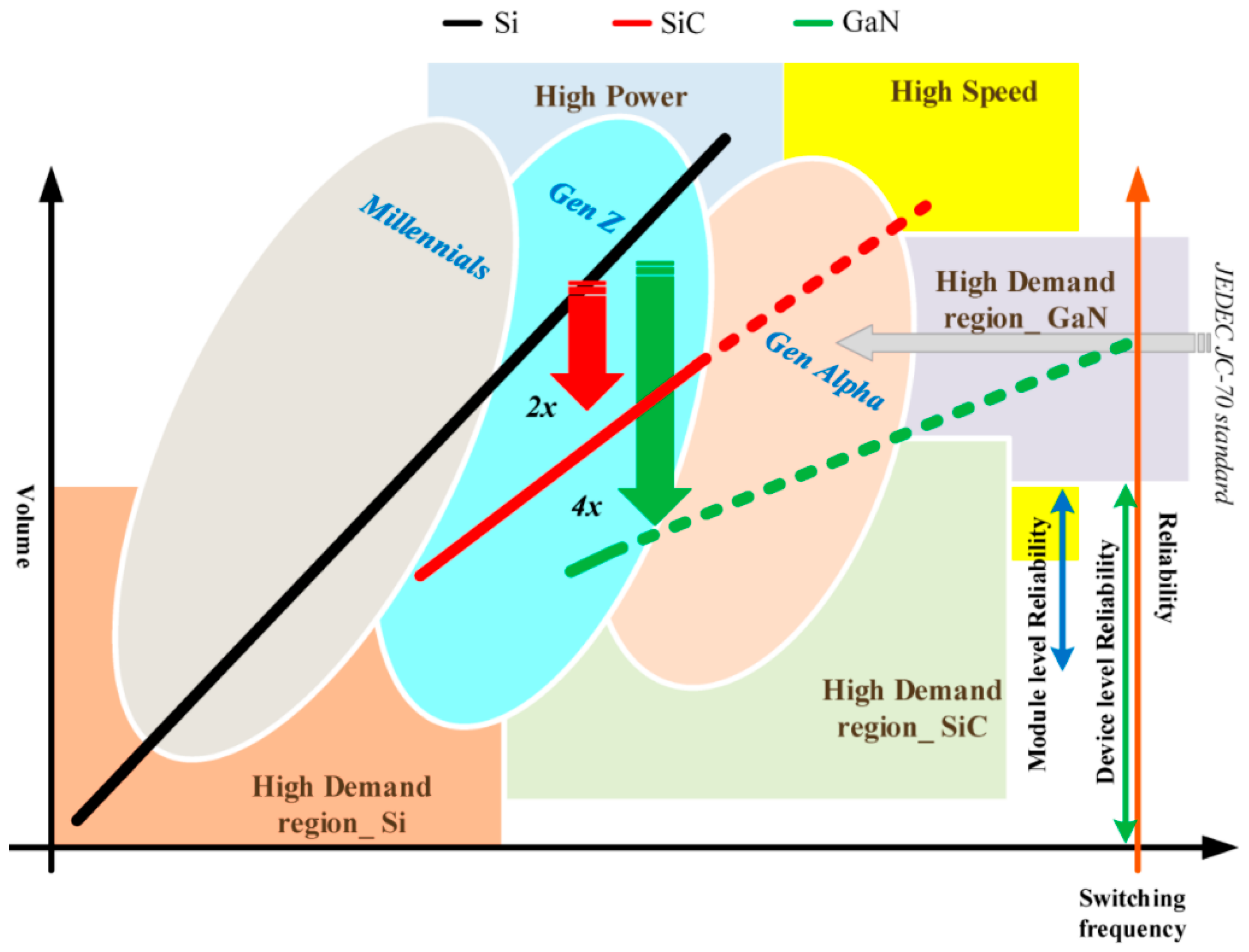



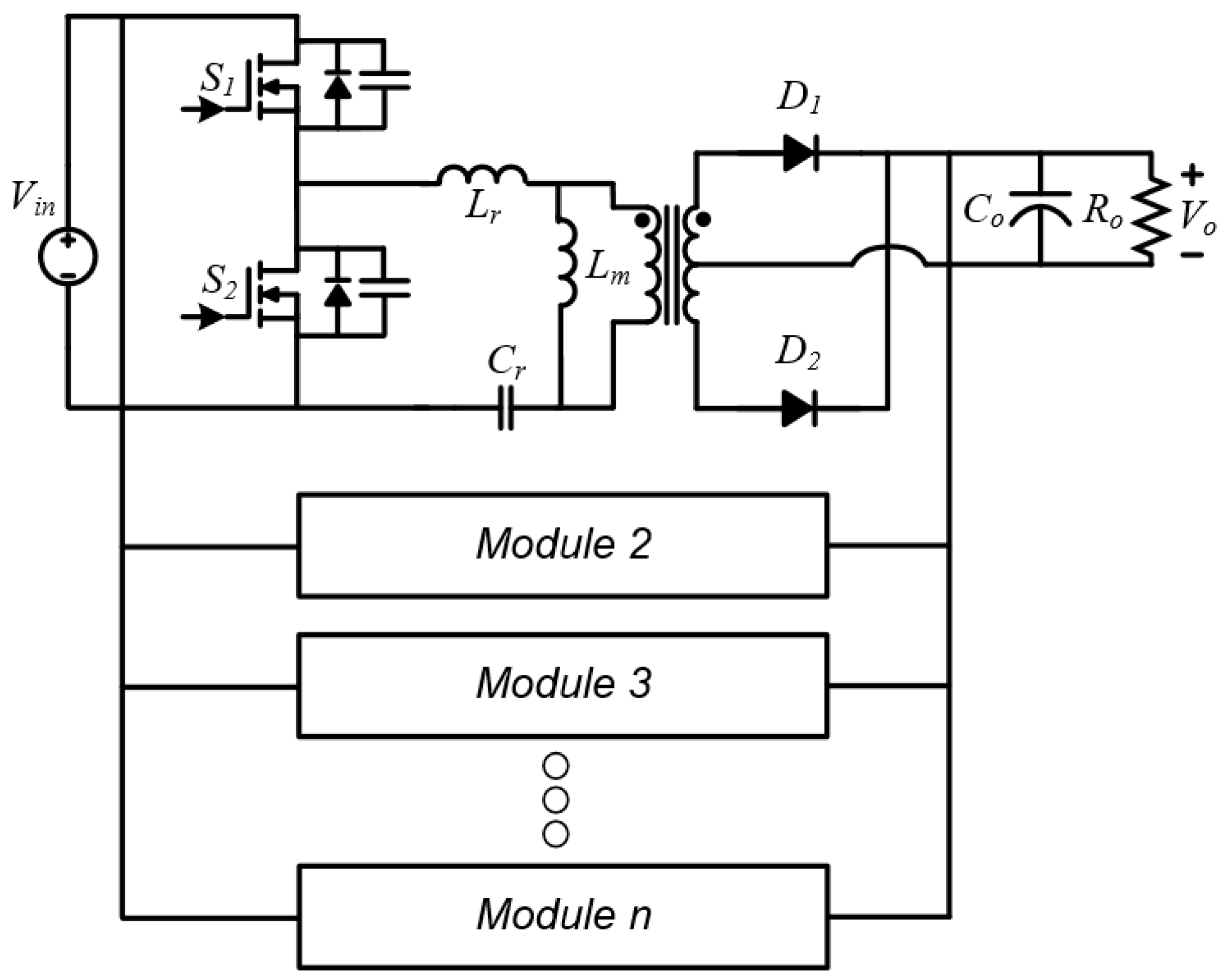

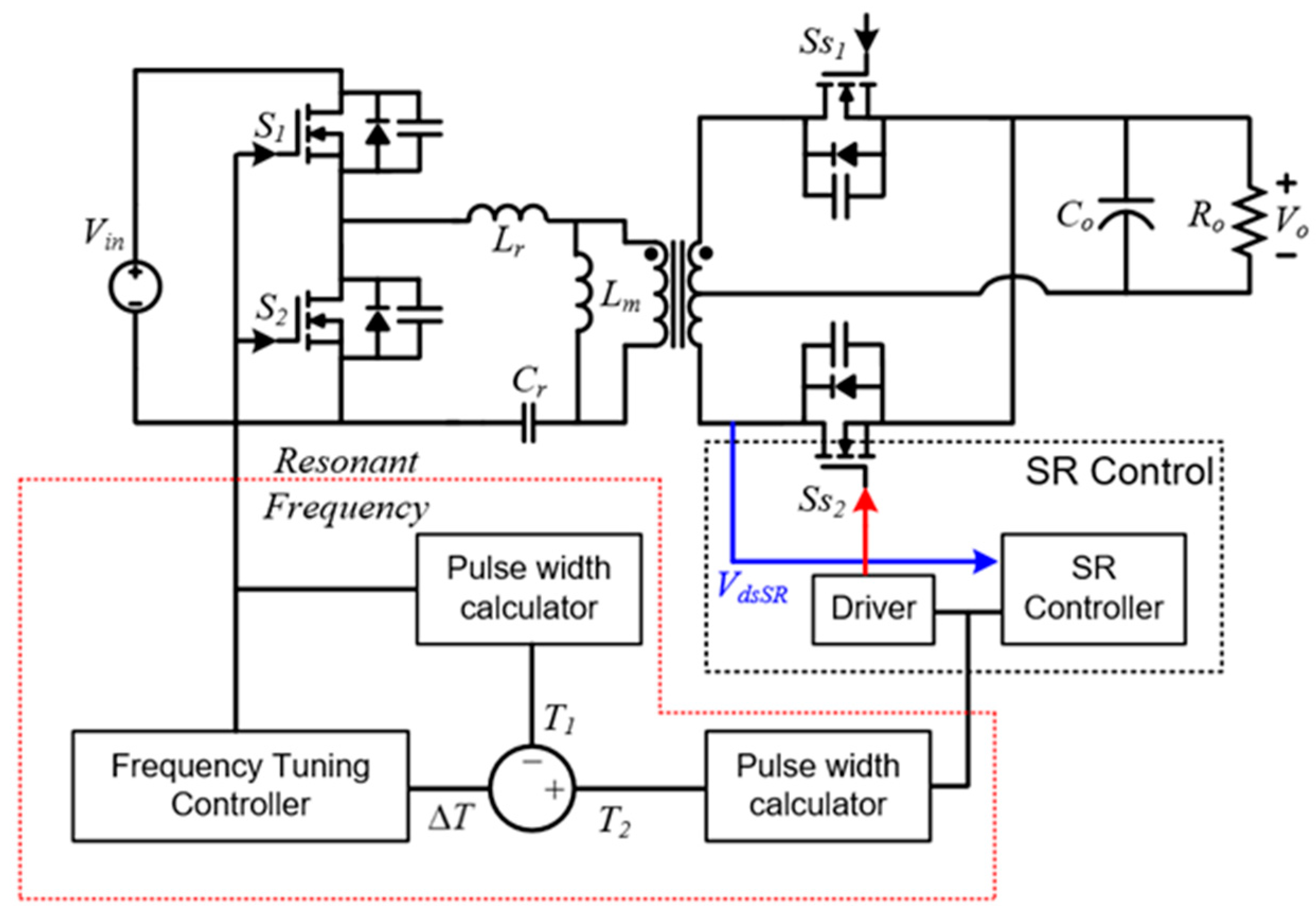
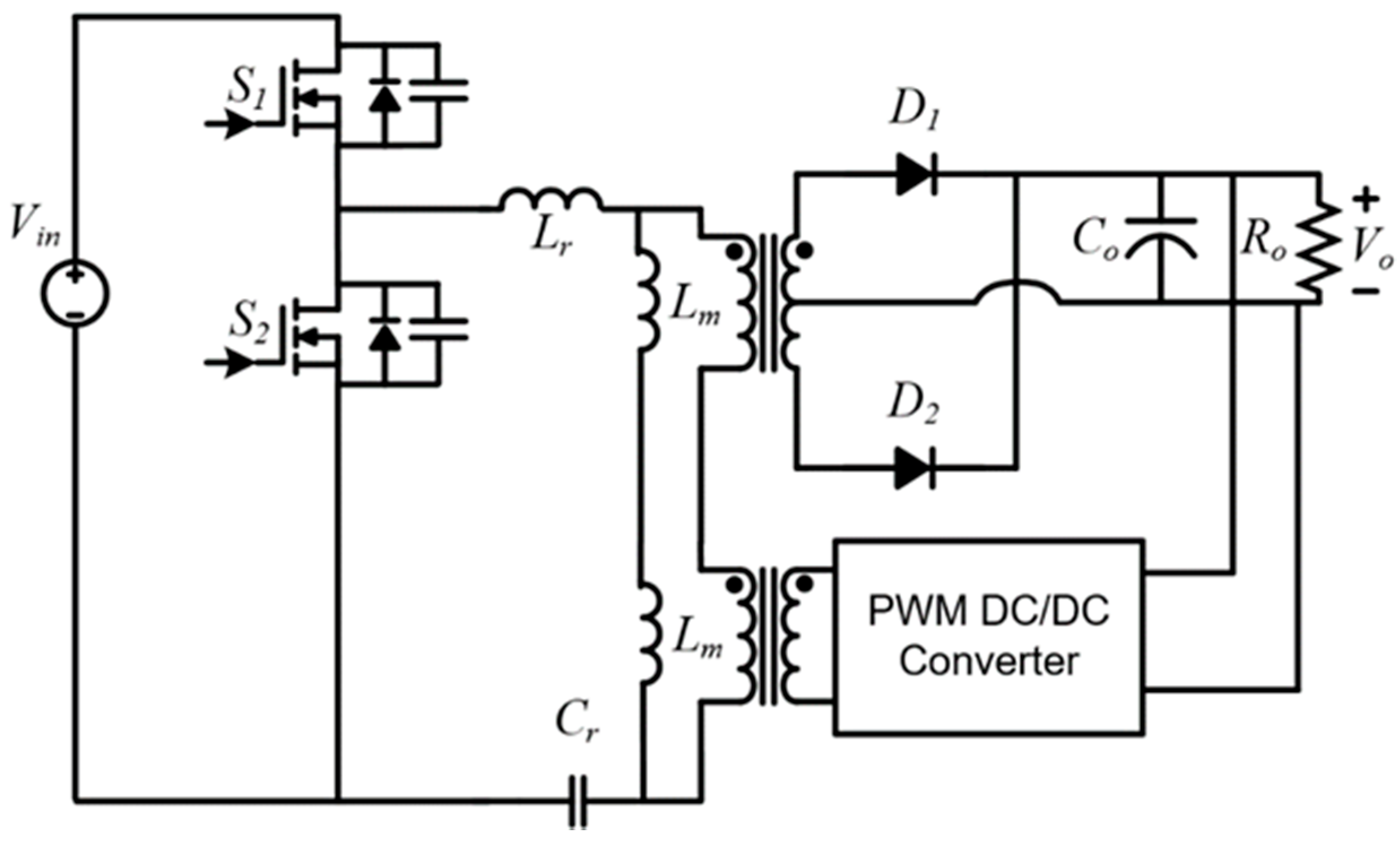

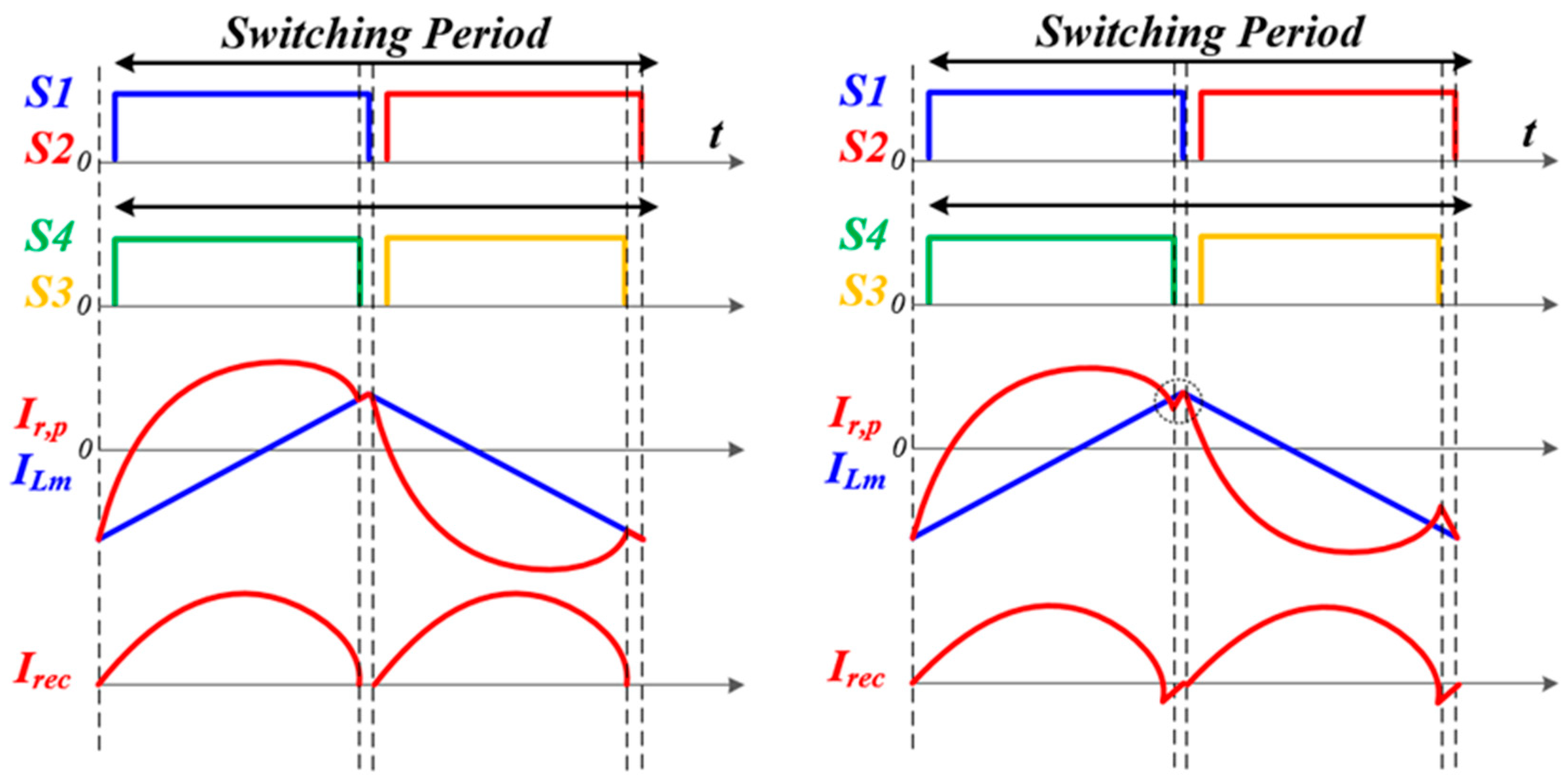


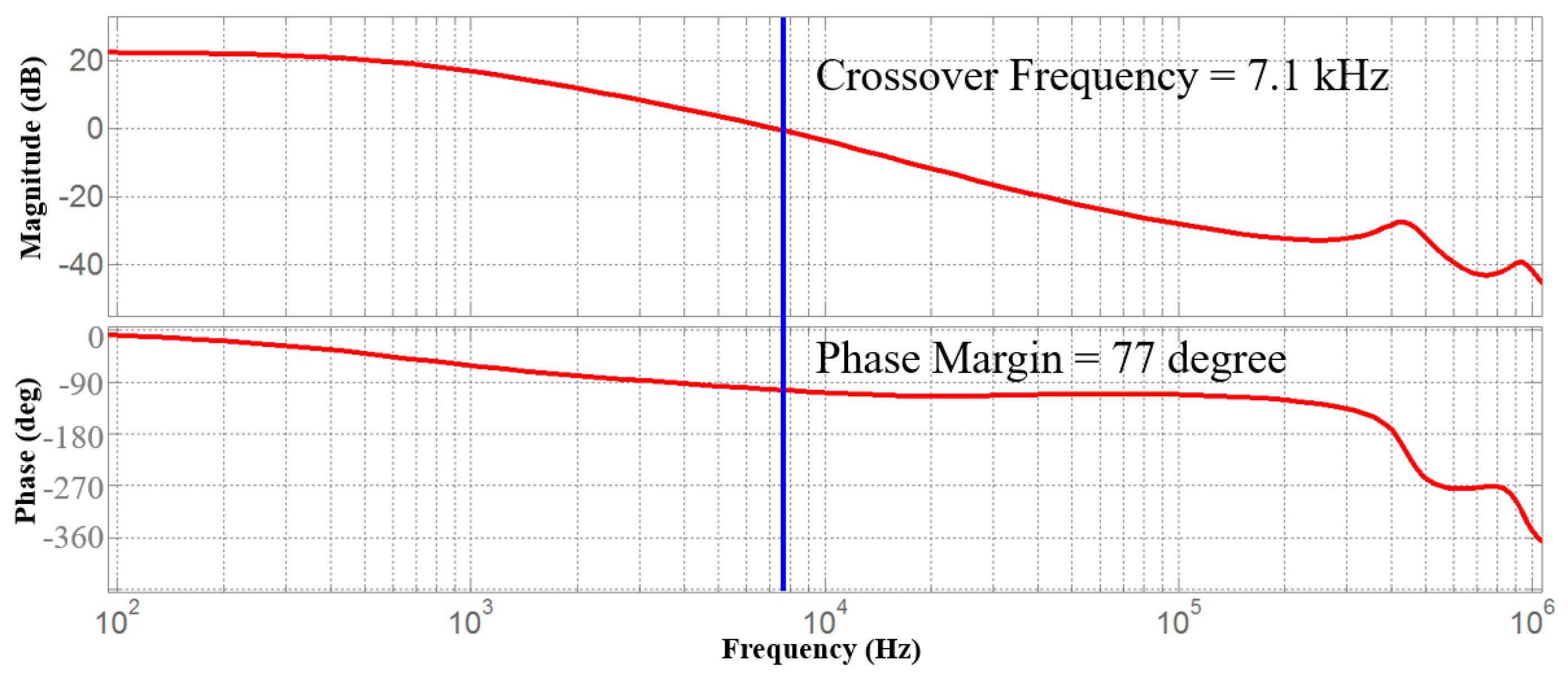
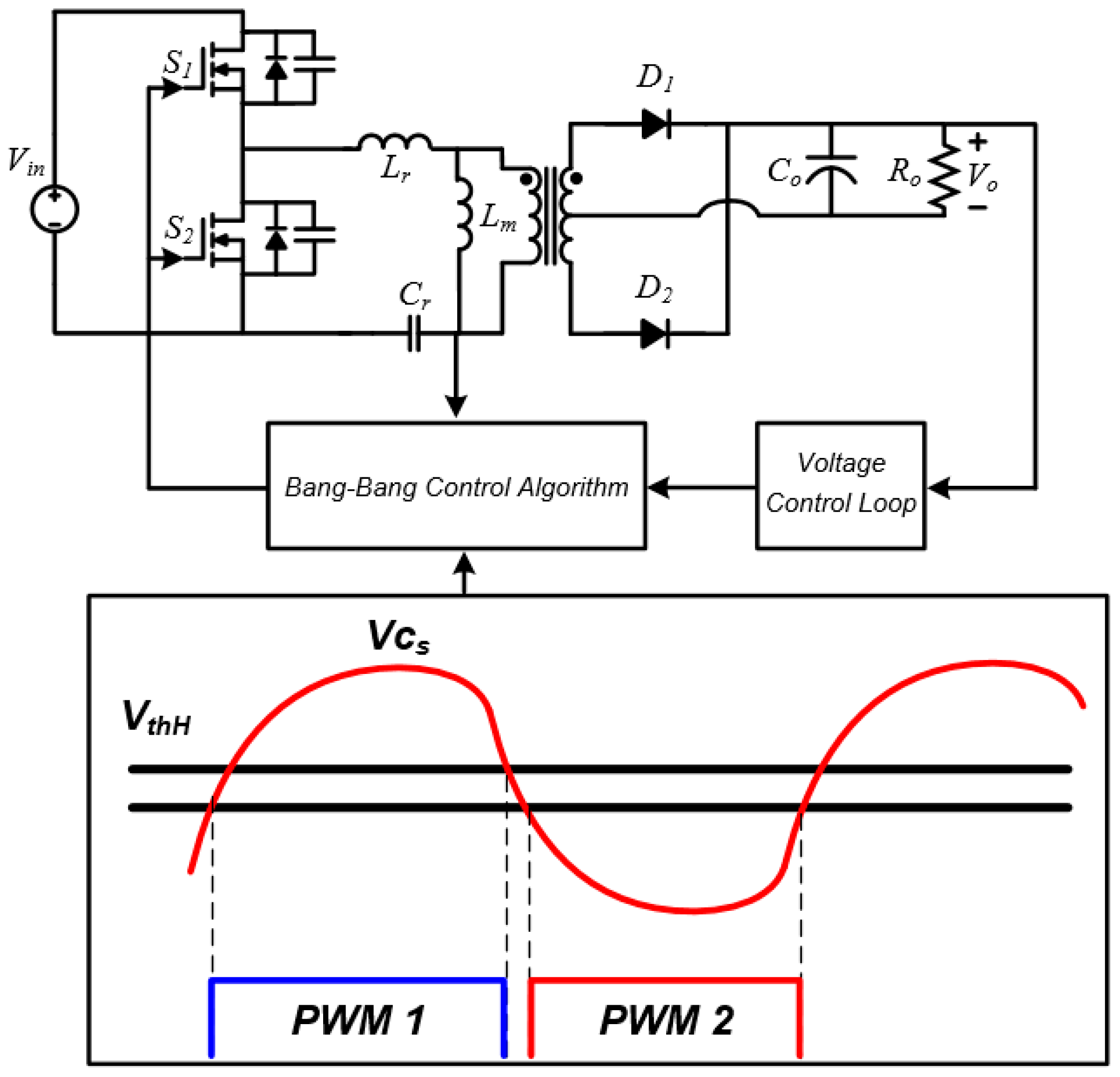

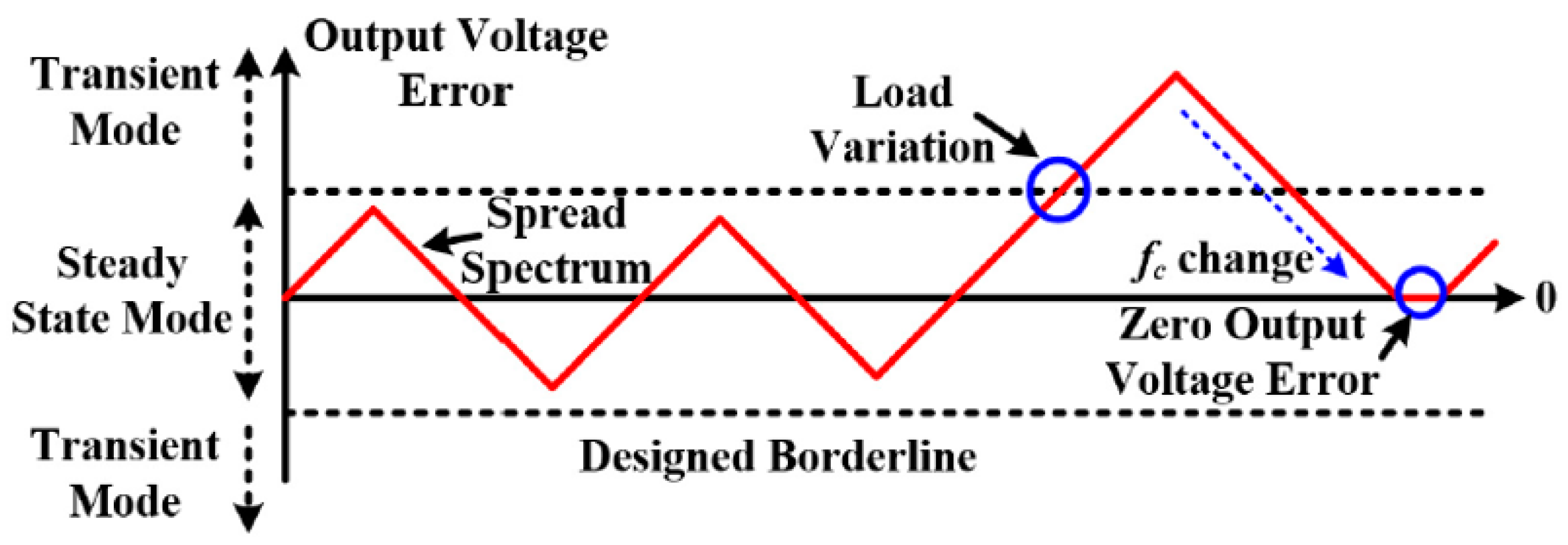

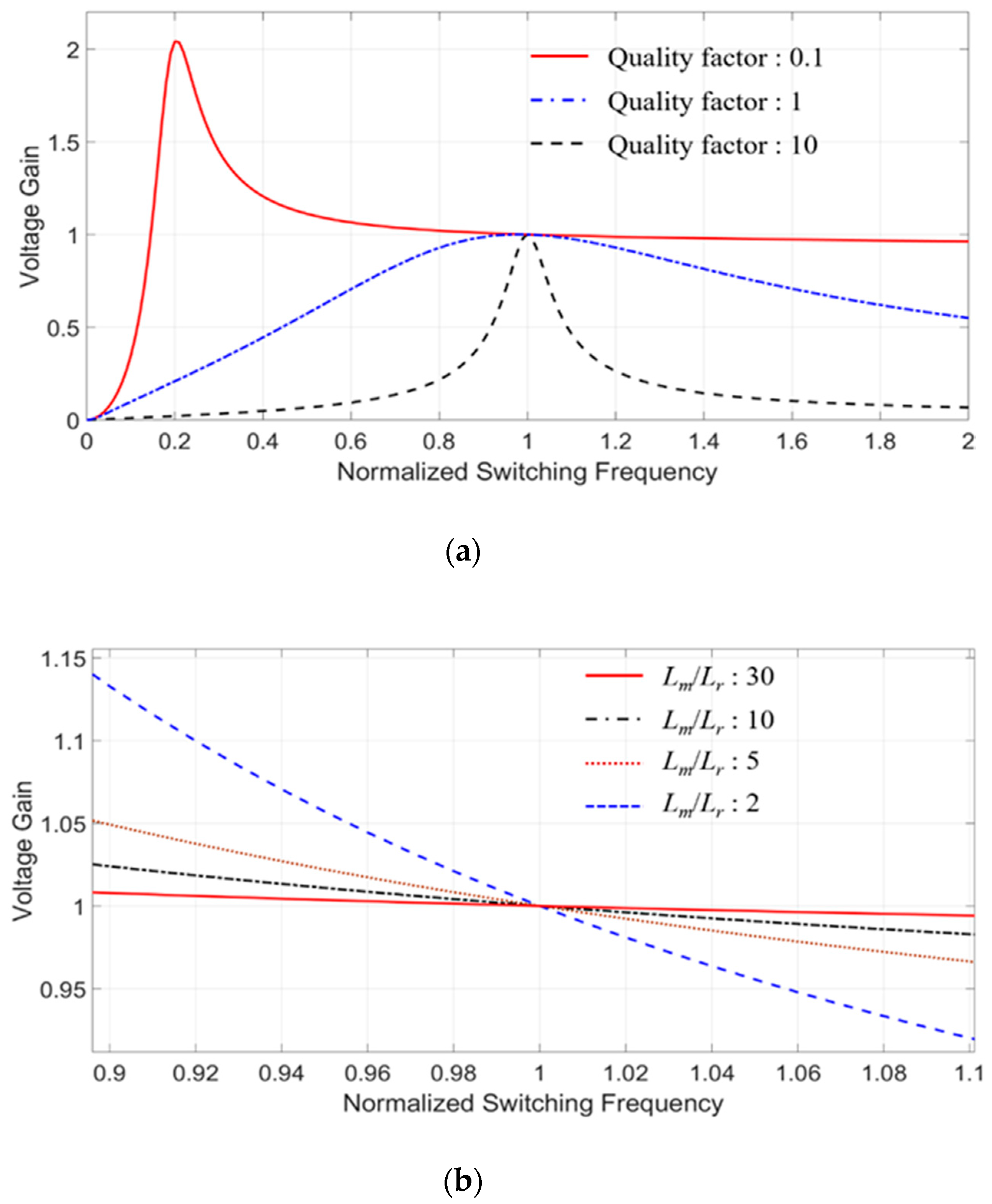
© 2020 by the authors. Licensee MDPI, Basel, Switzerland. This article is an open access article distributed under the terms and conditions of the Creative Commons Attribution (CC BY) license (http://creativecommons.org/licenses/by/4.0/).
Share and Cite
Park, H.-P.; Kim, M.; Jung, J.-H. A Comprehensive Overview in Control Algorithms for High Switching-Frequency LLC Resonant Converter. Energies 2020, 13, 4455. https://doi.org/10.3390/en13174455
Park H-P, Kim M, Jung J-H. A Comprehensive Overview in Control Algorithms for High Switching-Frequency LLC Resonant Converter. Energies. 2020; 13(17):4455. https://doi.org/10.3390/en13174455
Chicago/Turabian StylePark, Hwa-Pyeong, Mina Kim, and Jee-Hoon Jung. 2020. "A Comprehensive Overview in Control Algorithms for High Switching-Frequency LLC Resonant Converter" Energies 13, no. 17: 4455. https://doi.org/10.3390/en13174455
APA StylePark, H.-P., Kim, M., & Jung, J.-H. (2020). A Comprehensive Overview in Control Algorithms for High Switching-Frequency LLC Resonant Converter. Energies, 13(17), 4455. https://doi.org/10.3390/en13174455





